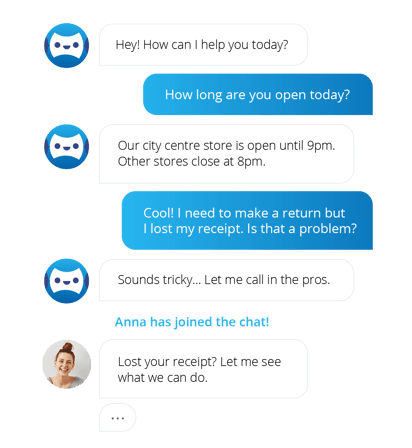Computer-controlled bots who can communicate with customers. That has been the dream of customer service professionals for quite a while now. Corporate giants have been testing them since the last decade but so far, we haven't seen them implemented at scale.
Once again, there's an industry-wide hype around chatbots but this time, that hype will pay off. And there are two simple reasons why they will actually make it.
 The chatbots are long expected to solve the huge efficiency problem in customer service: immensity of repetitive questions. Up to 80% of cases a customer service agent gets are simple, repetitive issues.
The chatbots are long expected to solve the huge efficiency problem in customer service: immensity of repetitive questions. Up to 80% of cases a customer service agent gets are simple, repetitive issues.
Customer service managers are wide aware of the problem and have spent hundreds of thousands of euros, if not millions, trying to solve it with FAQs, tutorials and better website design. It appears though, that people are not willing to browse FAQ-sections in the hopes of finding an answer, but want that answer handed to them with minimum effort.
Chatbots can do just that. They map out customers' questions and the best answers to those questions using sophisticated algorithms. As a result, a bot knows that a good answer to "hi" is "Hello, how I can I help you?" and to "When do you close today?" the right answer might be "9pm". But the problem is, that no matter how well the chatbot is trained, there will always be questions it interprets wrong or doesn't know the answer to.
In the previous years, chatbots have failed because at some point of the conversations, they simply stop making sense. Either the text interpretation fails or the chatbot's best answer is simply not the right answer. Regardless, the customer experience is utterly ruined. Time has passed, yet the customer is no closer to an answer.
How chatbots have developed
During the last years the development in text interpretation has been exceedingly rapid. That development has armed chatbots with better capability to understand what the customer really wants.
But the major reason why this wave of chatbots is different is elsewhere. The real breakthrough is this: The chatbots are able to analyse and react to their own failure.
When today's chatbot looks at a question with a list of possible answers, it estimates the level of confidence for each of the answers. It might be 90% sure that the first answer is correct, 67% sure about the second and only 57% about the third.
The customer service manager who set up the chatbot can determine that the chatbot only keeps the conversation going as long as the confidence level is above a certain rate, say 90% for example.
If the confidence level drops below that threshold, the bot apologises and calls up a customer service agent into the conversation. A real-life human being, who will take over the conversation while the bot goes quiet for the rest of the case.
The machines are not taking control (not yet at least)
The control of the customer service situation remains in the hands of humans. The chatbots are there to help - with every visitor and 24/7 if needed.
But if they give out poor answers that lower the customer satisfaction, all the manager needs to do is to pump up the chatbot's minimum confidence level and more of the conversations are transferred to customer service agents.
Once the chatbot has fully learned its lessons, it can run most conversations with above 90% confidence levels. And the customer service agents can concentrate on what they were hired to do: serve the customers with real questions and concerns.